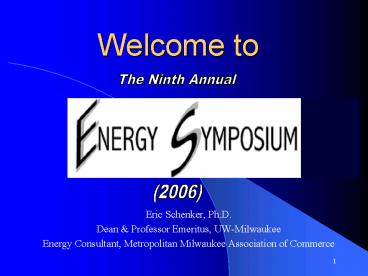Welcome to - PowerPoint PPT Presentation
1 / 13
Title:
Welcome to
Description:
M&I Bank Charter Steel Robert W. Baird Wisconsin Public Power, Inc. ... Participants' biographies. List of sponsors. Program agenda ... – PowerPoint PPT presentation
Number of Views:18
Avg rating:3.0/5.0
Title: Welcome to
1
Welcome to
The Ninth Annual
(2006)
- Eric Schenker, Ph.D.
- Dean Professor Emeritus, UW-Milwaukee
- Energy Consultant, Metropolitan Milwaukee
Association of Commerce
2
Primary Purpose of Symposium
3
Thank You
- Presenting Sponsor
- Co-Sponsors
- Alliant Energy American Transmission Company
Deloitte Touche - Johnson Controls, Inc. The Endeavor Group We
Energies Wisconsin Public Service - Contributing Sponsors
- MI Bank Charter Steel Robert W. Baird
Wisconsin Public Power, Inc. - African American Chamber of Commerce of Greater
Milwaukee - Hispanic Chamber of Commerce of Wisconsin
- University of Wisconsin-Milwaukee School of
Business Xcel Energy - The Business Journal Serving Greater Milwaukee
4
MMAC Folder Contents
- Copy of opening remarks
- Participants biographies
- List of sponsors
- Program agenda
- Energy Symposium proceedings, May 2005
5
Additional Information
- MMAC Web site
- www.mmac.org
- The Business Journal Special Insert
- Progressive Energy
- May 12th Edition
- Additional information available on tables
- in back of room
6
Delay is Not an OptionWidespread Agreement
Difficult Choices are Still Ahead
Demand reached all-time high in 2005
Inadequate transmission lines
Supply will outstrip demand by 2010
Power plant fleet is aging
Growing use of technology
Electricity markets in transition
7
Electricity Markets in TransitionEconomic
Report of the President, February 2006
- The electric power industry has gone
through a transition over the past several
decades, evolving from a highly regulated,
monopolistic industry to a less regulated, more
competitive industry. Traditionally, electric
utilities owned and operated electricity-generatin
g units, transmission lines, and distribution
systems, and were the sole providers of
electricity to a specific geographical area.
Federal legislation and rule-making activities
during the last decade, however, have opened up
access to transmission lines and encouraged
greater wholesale trade of electricity between
generators and retailers. The market changes
vary from state to state and are dynamic, with
continual adjustments being made as problems
emerge. Some states continue to operate under a
traditional, integrated market structure, others
are striving to encourage greater competition
among generating companies, and some even have
opened up competition between electricity
retailers.
8
Challenges
Rising energy costs
Litigation atmosphere in Wisconsin
Energy efficiency programs Who pays?
Utility rates Supply demand
Clean power and environmental advantages
Pressure on the PSC
Rewarding efficiency
Effective management, liability, ownership and
economies of scale of nuclear plants
Recent electricity market policy reforms
9
Recent Electricity Market Policy Reforms
Economic Report of the President, February 2006
- Provisions in the Energy Policy Act of 2005
signed by the President promote competition and
investment in transmission infrastructure by
providing for reasonably priced access to
transmission grids, while providing for the
establishment of mandatory reliability rules for
the electric system. In order to further reduce
costs and increase reliability, the Act repealed
the Public Utility Holding Company Act (PUHCA),
which restricted the ability of regulated
utilities to invest in electricity
infrastructure, and amended the Public Utility
Regulatory Policies Act (PURPA) to allow
utilities greater flexibility to purchase
wholesale electricity from producers with lower
costs. The Energy Policy Act of 2005 improves
market competition by promoting the dissemination
of information about the availability and prices
of wholesale electricity and transmission
services. The Act also protects consumers by
banning market manipulation, unauthorized
disclosure of consumer information, and unfair
trade practices, such as changing the electricity
service providers chosen by consumers without
their consent.
10
Progress 2005 2006
PSC approval of power plant and transmission line
construction
PSC and utilities planning for replacements
PSC focusing attention to efficiency
Efficiency incentives included in rate structure
Better understanding of Supply Demand and
rate of return
Utilities getting back to basics
New gas pipelines CONTEMPLATED
11
Program Agenda
755 a.m. Progress Update 2006 820 a.m. Rate
and Cost Trends Analysis Regulation and
Economic Development 900 a.m. Questions/Discuss
ion of Studies and Papers 1000 a.m. Looking at
what can be done to keep rates competitive and
reward efficiency 1115 a.m Energy Efficiency and
Conservation Understanding the Urgency
1215 p.m. Lunch and Symposium Summary 1245
p.m. Introduction of keynote speaker, Gov. Jim
Doyle
12
Report Card 2005
13
Introduction
- Chairman Dan Ebert
- Public Service Commission of Wisconsin
- Progress Update 2006































